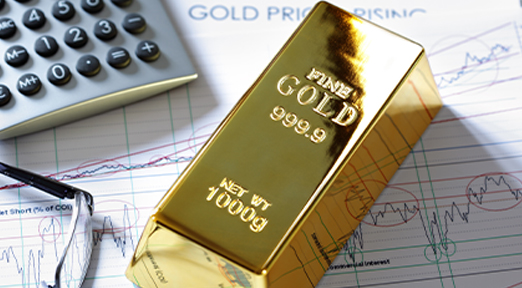
Russian, Ukraine and the gold price
The gold lowdown:
- Gold rose in price by approximately 8% in February.
- Gold’s trading high was £1,478 per troy ounce this week.
Gold prices generally go up during times of uncertainty and political unrest. And the situation in Ukraine is surrounded by both these aspects. The impact on the price of gold is therefore unsurprisingly substantial.
On the morning of Thursday 24th of February, President Vladimir Putin initiated an assault on Ukraine. It has become obvious that this is one of the most prolific attacks in Europe since World War Two, and could result in a conflict that has a grave and unprecedented impact on the rest of Europe and beyond.
Several cities within the country of 44 million are under constant siege, with the takeover of Khersen in the south as the most recent disaster. It has been reported that this is the first major city to fall. Considering all this information, it is inevitable that the consequences to human life will be severe. But the global economy will also take a big hit as the political situation develops. World markets have dropped drastically; the global market was certainly not anticipating a fully-fledged war.
Russia is creating major chaos across Kyiv and beyond, and as a result of this crisis, gold’s trading high this week was at a rate of £1,478 per troy ounce at the time of writing, and still climbing. The Russia-Ukraine conflict is epitomised by uncertainty and unrest which is a core factor in pushing up the value of gold.
On the 24th February, Putin’s army invaded Ukraine from the regions of Donbas in the east, Belarus to the north and Crimea in the south. The country is in a state of war. And Putin has now been accused of committing war crimes. There is a sense of desperation amongst Ukrainian refugees who have lost their homes and livelihoods. Missiles have been launched and casualties are building up. However, the Ukrainian people are fighting back with determination and are adamant not to let Russia destroy their valuable culture.
On an economic level, conflicts like this have pushed up the gold price in the past. Gold prices went up in late 2017 and early 2018 amid geopolitical tensions surrounding North Korea. Tensions between America and China had a similar effect.
The price of gold also rose during 2011 during a congressional conflict regarding the US debt ceiling. The potential for the break-up of the Eurozone continued to make investing one’s finances in something independent of sovereign currencies an appealing option. Incidentally, gold isn’t the only commodity affected by periods of uncertainty. Oil and soft commodity prices have rocketed up too. Acting as something of an international benchmark, Brent crude overtook $100 for the first time in 8 years.
Long-term uncertainty
The situation in Ukraine could last days, months or years; at the moment, we just don’t know. Looking back at historical market trends, we can see that in the past, longer term political turmoil came with challenges around inflation.
Back in the 1980s, it was the Iranian Islamic revolutionaries who created an atmosphere of fear around the partially oil-driven inflation of the 1970s. Inflation became even more severe when oil embargoes led to the increase of energy prices, slowing economies down and boosting inflation.
The current demand surge that has reared its head since the opening up of the economy after the COVID-19 shutdown is another factor that has recently increased energy prices. The situation in Ukraine will undoubtedly affect the price and supply of oil. This is particularly pertinent as Russia is one of the world’s most prolific energy providers.
Because of this fact, it is inevitable that there will be a surge in prices for exports which will cause disharmony within individual European economies and beyond. The COVID fuelled energy supply crisis, combined with the current Russia-Ukraine developments, is likely to make this problem worse.
Many investors will likely seek alternative and stable options to hedge against this forecast inflation. Investors in gold have historically seen gold hold or increase its value during times of economic instability; countering many other markets and assets. Gold is the go-to option for many investors when alternatives such as stocks and bonds, whose value is determined by confidence in the global economy, prove unreliable.
As is the norm in times of global crises, buying gold becomes an attractive way of storing your finances. However, only a few weeks ago, there was speculation that the price of gold would fall because of the possible easing of tension between Ukraine and Russia. As we all know now, the present reality is quite different, and so it looks like the value of gold will continue to increase – but as always in the markets, nothing is certain.
In late February, gold hit its peak in almost nine months and is up around four per cent this year. On the 24th of February, when Russia invaded Ukraine, gold rose again, reaching more than a one-and-a-half-year high. As we’ve touched on, this is likely a response to the instability of markets across the globe and the historical tendency to seek refuge in safe-haven metals during periods of crisis.
As we’ve explored in this article, gold can be one of the most secure investments in times of political unrest. So, if you’re looking to get away from the volatility of intangible investment options such as stocks and bonds, why not consider gold as part of your investment portfolio?
We have an extensive collection of both gold coins and bullion bars. Contact UK bullion to find out more about why gold is such a good investment and discover our range of products today.

+ There are no comments
Add yours